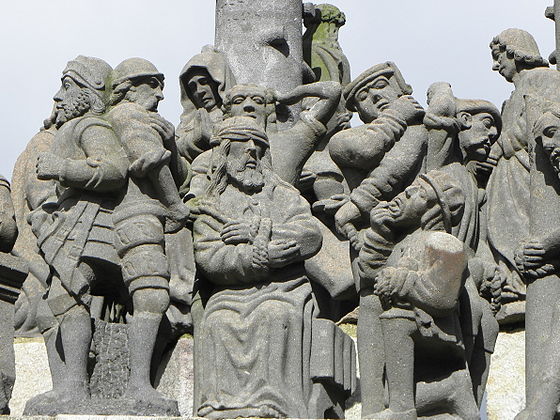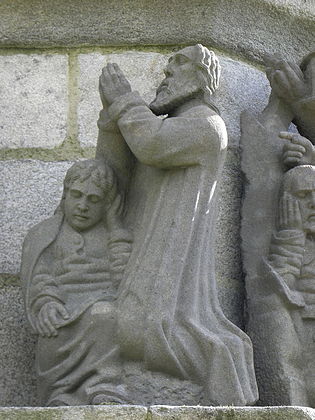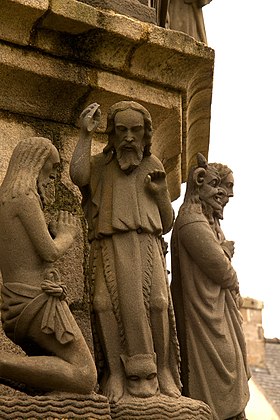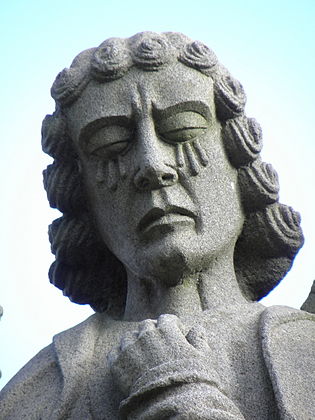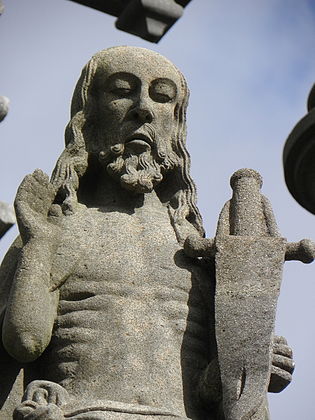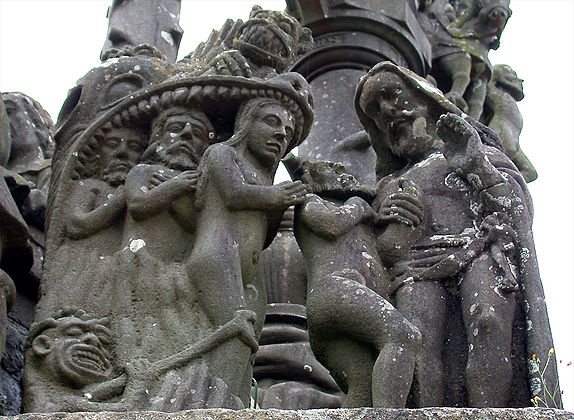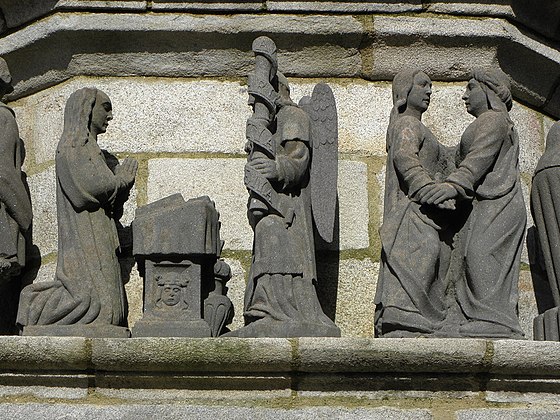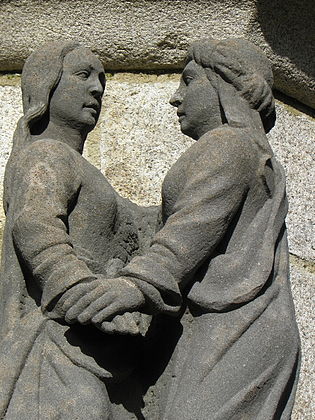
Ligier Richier was a 16th-century religious sculptor working in Lorraine, France and known in particular for his depictions of scenes from the "Passion of Christ". The various episodes of the Passion, between the arrest and the crucifixion of Christ, as recounted in the Gospels, were increasingly subject to representation in the Arts towards the end of the Middle Ages, in tandem with the growing popularity of the staging of theatrical mystery plays.
Yann Larc'hantec or Yann Larhantec was a Breton sculptor born in Plougonven on 30 May 1829. He died in Landerneau on 11 January 1913.
Roland Doré was a 17th-century sculptor and his workshop or "atelier" produced many sculptures for the enclos paroissiaux or "parish church enclosure or closes" of Brittany. In particular his work can be seen on calvaries and in the church's south porch. He was born in 1616 and died in 1660. Little detail of his life is known but it is recorded that he practised as an architect in Landerneau, as well as running his workshop, and was recorded as calling himself the "Sculpteur du Roi". His works, all of an ecclesiastical nature, are mainly located in Léon and the north of Cornouaille. They can be taken as works by Doré's workshop rather than just by Doré himself. Brittany is particularly rich in calvaries, some of a very elaborate nature. In most cases the calvary involves both the crucifixion cross and side crosses or gibbets bearing the good and the bad robbers. Below this, on the crosspieces, were statues of those present at the crucifixion. A feature of Breton calvaries is that most of the statues were carved as a pair and effectively back to back. Doré's output was prodigious and he worked on nine monuments in Saint-Thégonnec, five in Logonna-Daoulas and four in the parish of Plougastel-Daoulas. He also received four commissions to work in Hanvec, three in Guiclan, Irvillac and Lampaul-Guimiliau and two commissions in Cléden-Cap-Sizun, Hôpital-Camfrout, Landerneau, La Martyre, Plabennec, Pleyben, Plogonnec, Saint-Nic, Saint-Servais and Saint-Urbain.

The Calvary at Kergrist-Moëlou in the Arrondissement of Guingamp in Brittany, France, dates back to 1578. It was the work of the sculptor Guillaume Jézéquel except for the crucifix which was the work of the sculptor Yves Hernot de Lannion and was remounted on the calvary in 1896. Kergrist-Moëlou is located in the Côtes-d'Armor region, the ancient diocese of Cornouaille. Jézéquel had worked alongside his brother on the Kergrist-Moëlou church in 1554. Originally the calvary's sculpture was substantial, with records showing that it was decorated with almost one hundred statues telling the story of the life and death of Jesus Christ, but the calvary was vandalized during the 1793 French Revolution leaving many statues broken and decapitated with others disappearing completely. What is now left of the calvary stands on a large octagonal granite base and fragments of the mutilated figures are placed around the cross itself. This article gives some of the history of the calvary and describes its constituent parts.
The Calvary of Plougastel-Daoulas in the arrondissement of Brest comprises a raised octagonal pedestal made from the yellow granite of Logonna-Dāaoulas, flanked by four thick arched buttresses. All the sculptural work is by the Maître de Plougastel except the horseman on the left of the crucifix which is by Millet. It is a listed historical monument since 1889.
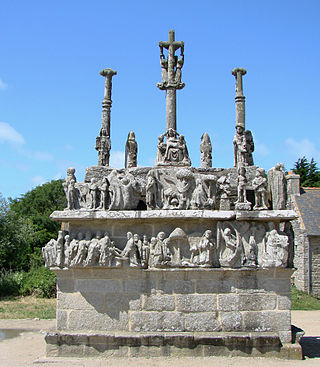
Calvary at Tronoën is a calvary located at Saint-Jean-Trolimon in the Quimper arrondissement. It is located in the "pays bigouden", a particularly wind swept area of Brittany; the nearby chapelle was called the "cathédrale des dunes".
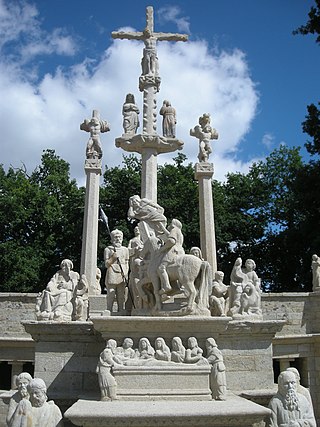
The Calvary of Guéhenno, dating from 1550, is located in the village of Guéhenno in the Pontivy arrondissement of Brittany. This article gives a full description of the calvary and details of how it was rebuilt after suffering severe damage in 1794. This calvary is classified as one of the seven great calvaries of Brittany and is the furthest to the east, being located in the ancient diocese of Vannes. It is made entirely from granite save for some bas-reliefs carved using "pierre bleutėe". The granite used is fine grained which lends itself to being carved. Extracted from the Guéhenno region, it was also used for the north porch at Ploërmel and the façade of the château at Josselin.
The Calvary at Guimiliau, completed in 1588, is located in Guimiliau, Brittany, in northwestern France. It is part of the Guimiliau "enclos paroissial".

The Calvary at Pleyben, dating from 1555, is located in the village of Pleyben in Brittany, northwestern France.
The Calvary at Saint-Thégonnec is part of the enclosure of the parish church of Notre-Dame in Saint-Thégonnec. Erected in 1610 it is the last of the monumental calvaries of Brittany. See also Saint-Thégonnec Parish close.

The Calvary at Landrévarzec is a monument in the form of a group statue in Quimper, Brittany, NW France. It is located in the commune of Landrévarzec in the arrondissement of Quimper, and stands next to the Chapelle Notre-Dame de Quilinen.

The Ploudiry Parish close is an enclos paroissial located at Ploudiry within the arrondissement of Brest, Brittany. It comprises a church, ossuary, and calvary. The Parish close was built between the 1630s and 1650s, with major renovations taking place in the 18th and 19th centuries.
The Pencran Parish close is located at Pencran in the arrondissement of Brest in Brittany in north-western France. The Notre-Dame church, the sacristy, the two calvaries, the ossuary and the surrounding wall are a listed historical monument since 1990. Records show that there has been a religious building in Pencran since the 14th century, and in 1353 there was mention of a chapel dedicated to the Virgin Mary. Until the French Revolution the parish of Ploudiry covered an area from Loc-Eguiner to Pencran, but it was in 1801 that Pencran became an independent parish.

The Lampaul-Guimiliau Parish close is located at Lampaul-Guimiliau in the arrondissement of Morlaix in Brittany in north-western France. It is a monumental churchyard belonging to the Église Notre-Dame in that town. This church was built in the late 16th century to replace an older one. The structures in the parish close date to the 16th and 17th century. It is a listed historical monument since 1910.

The Plougonven Parish close is located at Plougonven in the arrondissement of Morlaix in Finistère in Brittany in north-western France. The parish close comprises the church, an ossuary, the enclosure wall and the Calvary at Plougonven. It is a listed historical monument since 1916.

The Saint-Thégonnec Parish close is located at Saint-Thégonnec in the arrondissement of Morlaix in Brittany in north-western France. The enclos paroissial comprises the parish church of Notre-Dame, a triumphal arch and enclosure wall, an ossuary and the famous calvary. It is a listed historical monument. There is a second calvary set into the enclosure wall and the war memorial dedicated to those lost in the 1914-1918 war is also set into another section of the wall.

The Locmélar Parish close is located at Locmélar in the arrondissement of Morlaix in Brittany in north-western France. It is a listed historical monument since 1934.

The enclos paroissial or Parish close of Locronan comprises the parish church with adjoining chapel and a calvary. The article will also cover the nearby chapelle Notre-Dame-de-Bonne-Nouvelle. Locronan is a member of the Les Plus Beaux Villages de France association. The village's name means the "hermitage of Ronan", from the Breton lok which means hermitage, and after the founder Saint Ronan. It has previously been known as Saint-René-du-Bois. Saint Ronan is greatly venerated in Brittany. He was an Irish Christian missionary of the 6th century who came to the region to teach Christianity. As a consequence of Saint Ronan's close association with Locronan some of his relics are kept in the parish church. Locronan is located in the Châteaulin arrondissement of Finistère.



